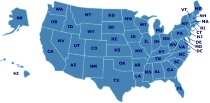Manipulatives
The use of manipulatives are a creative and fun way to introduce and reinforce learning, especially in the area of mathematics.
Resources
Idea Book For Cuisenaire Rods At The Primary Level
Grades K-4. Each 120 page book contains worksheets and has selected activities that cover the major math standards. Each page outlines the grade level, materials needed, settings, learning experiences, and are based on NCTM Standards.
Bead Sequencing Set
Stack the durable, brightly colored wooden beads on 5 hardwood dowels in sequence to match the design on one of the pattern cards. Builds complex reasoning skills as well as sorting and coordination. Includes over 45 brilliantly colored beads, 5 dowels, and 10 patterns that increase in difficulty.
Flip Over Math Manipulatives
Grades 1-5. Tub of over 500 manipulatives includes Pattern Blocks, Connecting People, Cuisenaire Rods, Coins, and Bean Counters and can be used with the Flip Over Math Books. This 49 page book (others sold separately) is written to NCTM Standards and provide hands on activities from basic math skills to advanced problem solving.
Cuisenaire Rods Multi-Pack
Grades Pre K & up. An economical way to bring rods into the classroom. Pack contains six sets of 74 rods, six trays with, and Teacher's Guide. For use with 12-18 students.
Pattern Blocks and Boards
This set of 10 simply designed colorful wooden blocks and pattern boards includes 100 blocks in six different shapes and colors. They help develop shape recognition and spatial relationship skills. The contents store neatly in a durable wooden case. This games was awarded the Scholastic Parent & Child's 2004 "Top 22 Toys that Make Kids Think" award.
Idea Book For Cuisenaire Rods At The Intermediate Level
Grades 2-5. Idea Book designed for use with Cuisenaire Rods.
Using Manipulatives in Your Homeschool
5 DIY Manipulatives for Preschool and Kindergarten
These manipulatives are easy to make at home. They provide early learning supplies for anyone on a budget.
Virtual Manipulatives for Interactive Mathematics
This website features online games and interactive activities designed to help children learn and understand mathematical concepts. You can choose any grade level from pre-K to 12, and subjects including numbers and operations, algebra, geometry, measurements, data analysis, and probability. You'll find virtual peg boards, geoboards, fractals, charts, games, and much more.
How to Make the Most of Math Manipulatives
Marilyn Burns discusses creative and effective ways to use manipulatives to teach math. Much of her information is oriented towards classroom instruction, but there is great information for homeschoolers too. She discusses the seven "musts" for using manipulatives, how to introduce a Geoboard, pattern block activities, and more.
Math-U-See Users Group
This email group is for lovers and users of the Math-U-See program.
Featured Resources
As an Amazon Associate, we earn from qualifying purchases. We get commissions for purchases made through links on this site.
The Well-Trained Mind: A Guide to Classical Education at Home
This book will instruct you, step by step, on how to give your child an academically rigorous, comprehensive education from preschool through high school. Two veteran home educators outline the classical pattern of education—the trivium—which organizes learning around the maturing capacity of the child's mind: the elementary school "grammar stage," the middle school "logic stage," and the high school "rhetoric stage." Using the trivium as your model, you'll be able to instruct your child in all ...
Idea Book For Cuisenaire Rods At The Primary Level
Grades K-4. Each 120 page book contains worksheets and has selected activities that cover the major math standards. Each page outlines the grade level, materials needed, settings, learning experiences, and are based on NCTM Standards.
Tomorrows Child
Tomorrow's Child magazine offers insights and information that helps parents to feel confident that Montessori will prepare their children for the real world. It will help you understand and appreciate Montessori and apply it in your home.
Drawn Into the Heart of Reading
Drawn Into the Heart of Reading was developed for use with students of multiple ages at the same time, perfect for the homeschooling family. It is designed for use as an entire reading program or as a supplement to an existing program for students in grades 2-8.
H. A. Guerber's Histories
Helene A. Guerber wrote histories for grammar school children in the 19th century. Published in 1896 by the American Book Company, ‘Guerber’s Historical Readers in the Eclectic Readings Series’ were used to introduce children to the histories of the ancient and classical world. These engaging narratives are richly detailed accounts of the lives and times of the most important people of the period, arranged chronologically. The people are placed within the context of their times, and their histor...








